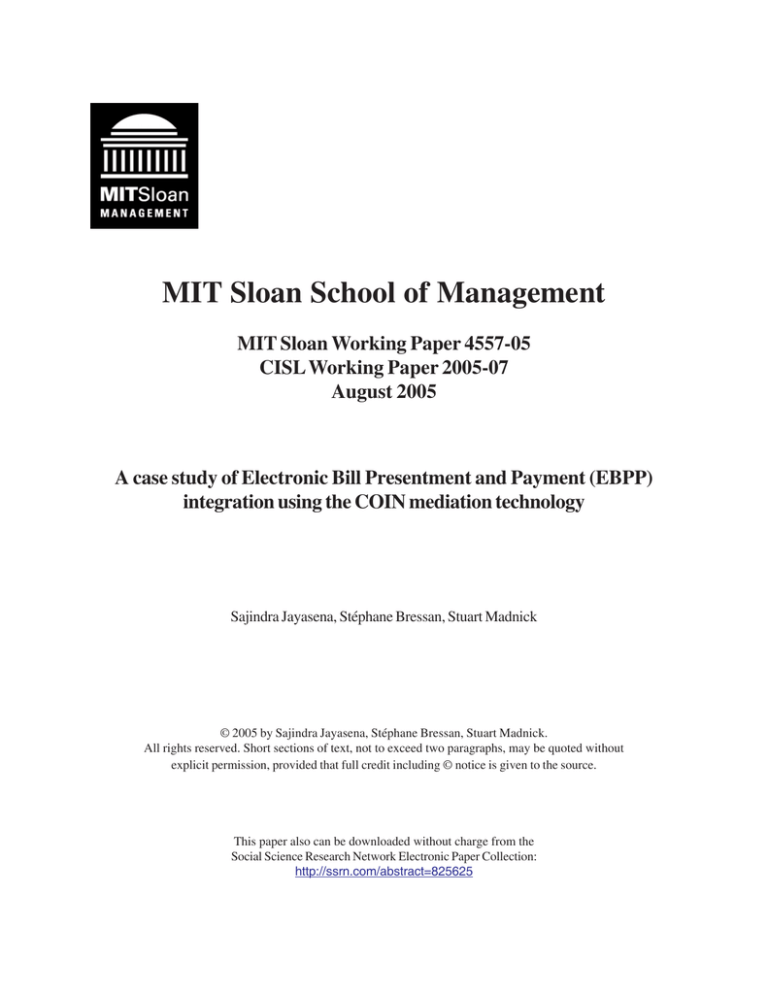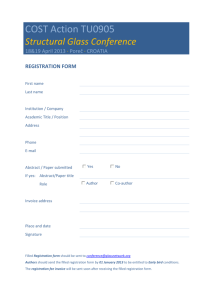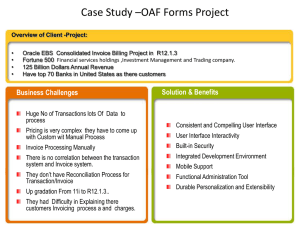
MIT Sloan School of Management
MIT Sloan Working Paper 4557-05
CISL Working Paper 2005-07
August 2005
A case study of Electronic Bill Presentment and Payment (EBPP)
integration using the COIN mediation technology
Sajindra Jayasena, Stéphane Bressan, Stuart Madnick
© 2005 by Sajindra Jayasena, Stéphane Bressan, Stuart Madnick.
All rights reserved. Short sections of text, not to exceed two paragraphs, may be quoted without
explicit permission, provided that full credit including © notice is given to the source.
This paper also can be downloaded without charge from the
Social Science Research Network Electronic Paper Collection:
http://ssrn.com/abstract=825625
A case study of
Electronic Bill Presentment and Payment (EBPP)
integration using the COIN mediation technology
Sajindra Jayasena, Stéphane Bressan, Stuart Madnick
Working Paper CISL# 2005-07
August 2005
Composite Information Systems Laboratory (CISL)
Sloan School of Management, Room E53-320
Massachusetts Institute of Technology
Cambridge, MA 02142
1
A case study of Electronic Bill Presentment and Payment (EBPP)
integration using the COIN mediation technology
Sajindra Jayasena1, Stéphane Bressan2, Stuart Madnick3
1
Singapore-MIT Alliance ,2School of Computing, National University of Singapore
3
Sloan School of Management, Massachusetts Institute of Technology
1
Sajindra@mit.edu, 2steph@nus.edu.sg, 3smadnick@mit.edu
Abstract
There is no such monopoly as ‘The World Wide Bank’ that manages the databases of all
possible financial activities. Such a concept makes neither technical nor business sense. Each
player in the financial industry, each bank, stock exchange, government agency, or insurance
company, operates its own internal financial information systems.
By its very nature, financial information, like the money that it represents, changes hands.
Therefore the interoperation of financial information systems is the cornerstone of the financial
services they support. Naturally the critical economic role and the complexity of financial
information led to the development of standards for its management and interchange. Yet
standards are not the panacea: different groups of players use different standards or versions of a
standard’s implementation.
In this paper we illustrate the nature of the problem in the Electronic Bill Presentment and
Payment industry. In particular, we describe and analyze the difficulty of the integration of
services using four different formats: IFX, OFX and SWIFT standards, and an example
proprietary format. We then propose an improved way to accomplish this integration using the
COntext INterchange (COIN) framework.
2
Main Body
Introduction
Effective, efficient and transparent interoperability is vital for the profitability and sustainability of the
financial Industry. Merely adhering to a standard does not pay rich dividends when multiple institutions
and geographical segments utilize different standards. Even when within one standard, one often finds
different possible interpretations originating in the practices and cultural background of the various players.
Typically, a Financial Institution (FI) that is involved in the Electronic Bill Presentment and Payment
Industry is faced with a multitude of standards such as IFX (Interactive Financial Exchange protocol)[10],
OFX (Open Financial Exchange Protocol)[9] and the world wide inter-bank messaging protocol, SWIFT
[11]. Making matters worse, the FI may have its own semantics for its internal systems that represent the
same business domain but in a different context. In the rest of this paper we would be referring to the IFX,
OFX and SWIFT standards in EBPP point of view as IFX, OFX and SWIFT context and the Internal
financial system of a Financial Institution as an internal context.
The Price and Invoice concepts may be represented in different ways, e.g., excluding tax, with tax
and fees, and even with inter-bank charges, resulting in definitional conflict due to contextual differences
[1]. Interoperability of such definitional conflicts is vital in distinguishing intra-bank and inter-bank
payment across borders. Further, different contextual heterogeneities exist on the currency, where in certain
contexts like IFX and OFX; it is implicitly based on where the funds are directed to. As a result of different
Account types and BANK/BRANCH code, financial institution would need to maintain complex mappings
between different contexts. In addition, there can be data level heterogeneities like date formats and
representations. Examples of possible conflicts are summarized in table 1. The columns in the table related
to OFX, IFX, and SWIFT represents actual real-life conflicts and similarities that exists between those
standards while the conflicts addressed under the internal schema refers to an hypothetical but realistic,
financial system utilized by a Financial system that would interact between OFX,IFX and SWIFT
standards.
Property
Price
Internal Schema
1000 EUR
(Euros)
OFX
1000 USD + 1000 *
5%
IFX
1000 USD + 1000 *
5%
Currency
FFR
Account types
CHK,SVG,
MNYMRT
Internal ID
Currency of country of
incorporation of payee
bank i.e. USD
CHECKING, SAVINGS
Currency of country
of incorporation of
payee bank i.e. USD
DDA,SDA
Dependent on the
country i.e. clearing
#,sort #
Net + fees + tax
20020223
Dependent on the
country i.e. clearing
#,sort #
Net + fees + tax
2002-03-23
Bank and
branch code
Invoice
Due date
Net
23022002
SWIFT 103/103+
1000 USD + 1000* 5% + 10
USD (inter-bank charge if
outside EU)
Specified in message – can
be the payee or payer’s
currency
N/A
BIC / BEI
(branch ID + bank Id)
Included in Amount – N/A
030223
Table 1: Some conflicts in different financial standards
The objective of this paper is to analyze how the COIN mediation technology [2, 3, and 8] could be
applied to provide a declarative, transparent yet effective mediation solution to the potential sources of
heterogeneity and conflicts that exist within and among the existing financial standards
3
Case Study
Electronic Bill Presentment and Payment domain
The ‘Electronic Bill Presentment any Payment – (EBPP)’ domain is a rich subset of the financial
services messaging frameworks and it has a considerable amount of heterogeneities. The main standards
are OFX, IFX for intra-bank payment schemes and SWIFT for inter-bank payment and funds transfer.
These standards may interact in various ways, as depicted in Figure 1.
Fig. 1. Some interfaces in EBPP
For brevity, in order to depict the usage of COIN in EBPP mediation in a practical scenario, we have
broken down the analysis to three main areas that spans from a customer initiating a Bill payment and its
subsequent verification by the Biller. The conflict analysis and mediation with the diverse financial
standards have been analyzed with respect to the hypothetical internal system of a Financial Institution
which could be an in-house developed system or third-party (off the shelf) system. This internal system is
represented by the term ‘internal context’. Following are the three main areas analyzed in the case study.
• Mediation between an internal context and OFX context.
• Mediation between an internal context and IFX context.
• Mediation between an internal context and SWIFT context.
The IFX, OFX and SWIFT contexts represent the semantics and definitions adopted by IFX, OFX and
SWIFT messaging frameworks respectively. SWIFT distinguishes intra European Union (EU) fund transfer
and outside EU fund transfers for accounting for inter-bank charges.
Figure 2 represents the context independent, COIN domain ontology for the EBPP domain denoting the
concepts used by IFX, OFX, SWIFT and financial institution’s own internal schema. This was constructed
by exploring the business domain in EBPP and the relevant message handling semantics used in these
diverse standards. The semantic types (entities) represent the business entities that encompass the main
functionalities in EBPP Industry. The semantic types denote the entities and their relationships in the EBPP
domain like Payment, Account etc. is-a relation denotes a inheritance relationship between semantic types.
Attribute lines represents attributes a certain semantic type possesses (payment has payee, payer accounts,
amount etc). Further the entities that constitute conflicts in these contexts are modeled through modifiers.
As an example, the paymentAmount can include/exclude various taxes in different contextual
representations and in SWIFT it would incur an additional inter-bank service charge. These are represented
by COIN modifiers paymentScheme, includesInterBankCharge respectively. Further all monetary amounts
would have conflict in different currency usage. This is modeled using the currency modifier for the supersemantic type moneyAmount. This represents how COIN models inheritance of contextual knowledge for
different entities.
4
Fig. 2. Domain Ontology for EBPP
The mediations that we focus in this section resemble some actual real life scenarios that are faced while
attempting heterogeneous systems integration. In this exercise these heterogeneities were extracted by
analyzing the standards documentation of SWIFT, IFX and OFX as well as from the conflicts we
introduced in the internal context which is hypothetical yet resembles a real life internal EBPP system of a
Financial Institution. In an actual scenario, the heterogeneities and mappings for the different mediation
could be analyzed and formulated by a business analyst or a person in that caliber working for the
respective Financial Institution. Following sections addresses each one of them separately.
Internal Schema vs. OFX
First we will look at the mediations attempted between OFX and an internal schema of a financial
institution. Table 2 summarizes the heterogeneities identified in the two schemas. As denoted in COIN’s
mediation strategy, the modifiers and relevant conversion functions are the main ingredients in facilitating
the mediation for a particular heterogeneity exiting between two different contexts. As shown in the table,
there are different types of heterogeneities between the two contexts. The significant conflicts are payment
amount, currency type and Account code reference identifiers. They are discussed below.
Table 2: Conflicts in Internal and OFX contexts that were mediated using COIN
Conflict
Payment amount
Account Location
Identifier –
BANK reference
Account Location
Identifier –
BANK BRANCH
reference
Payment due date
format
Payment due date
Style
Account type code
Currency type
(Exchange rate)
Phone number format
Internal Ontology
Net amount without tax
Bank identifier represented
in the internal scheme
Branch identifier of the
account
European format
dd/mm/yyyy
03/03/2003
CHECKING,SAVINGS etc
“EUR”
415.445.4345
OFX Ontology
Net + tax amount
Bank Identifier depends on
the Bank’s country of
Incorporation.
Branch Identifier dependent
on the bank’s country of
incorporation.
US format
Yyyymmdd
20030303
CHK,SVG etc
Currency of country of
incorporation of payee bank
1-415-445-4345
Mapped modifier
( refer Fig 2 )
PaymentScheme
BankLoc
BranchLoc
DateFormat
DateStyle
AccountCodeScheme
Currency
PhoneNumberScheme
5
Payment amount - The mediation strategy for payment amount is as follows. The mediator needs to apply
two conversion functions in order to obtain the mediated payment amount, namely the currency conversion
inherited from the moneyAmount super semantic type, and the tax adjustment for the payment. For
simplicity let’s assume that in both schemas the currency is denoted in three letter ISO 4217 format (i.e.
USD, GBP, and EUR etc).
Assume that the query ‘select AMOUNT from PAYMENT’ is called in OFX context;
First, payment amount is adjusted for the tax inclusion. For simplicity let’s assume that the applicable tax is
‘GST’. Then;
(1)
Payment OFX = (payment INTERNAL +
GST amount for payment OFX * payment INTERNAL )
∑
* Exchange Rate (“EUR”, OFF_CUR,DATE_OF_TRANSACTION)
In the COIN framework, the mediation formulas are translated into logical expressions of the COIN
theoretical model [1]. Later these expressions are evaluated by a Prolog-based abduction engine [13]. The
following describes the logical representation of the formula (1) for this example.
The formula1 below describes a non-commutative mediation of paymentType object depending on its
modifier paymentScheme, in this case hold the values “noTax” and “withTax”. The Ctxt defines the
destination context. The conversion in simple terms would be to retrieve the Rate for the tax “GST” from
the elevated relation ‘OFX_TAX_TYPES_p' which is an elevation mapped to relation ‘OFX_TAX_TYPES’
under OFX Context (The destination context in this case) and utilizes in the tax calculation. The value
predicate in the formula defines a value of a particular semantic object under a certain context.
cvt(noncommutative,paymentAmt,_O,paymentScheme,Ctxt,"notax",Vs,"withtax"
,Vt) ⇐
value(TaxName,Ctxt,"GST"),'OFX_TAX_TYPES_p'(TaxName,_,Rate),
value(Rate,Ctxt,RR),
(Vtemp is RR * Vs),
(Vt is Vs + Vtemp).
Further, this resembles an Equational ontological heterogeneity addressed in [5], which is a clear example
of differences in the two ontologies for OFX and internal contexts. But the ontological conflict has been
transformed into a contextual heterogeneity by way of matching the definitional equations as in [5].
Then, this tax adjusted payment needs to be mediate to the currency of OFX context. This requires a
dynamic modifier to determine the currency value depending on the official currency in the incorporated
country of the payee’s bank as given below.
OFF_CUROFX = CurrencyOFX (payment)
BRANCHOFX
BANKOFX
COUNTRYOFX
OFF_CUROFX
⇐ AID = Payee Account of PaymentINTERNAL
⇐ Branch of Account AIDOFX
⇐ Bank of BRANCHOFX
⇐ country of Incorporation of BANKOFX
⇐ official currency of COUNTRYOFX
(2)
The following logical representation describes how the value of modifier currency for paymentAmount is
obtained for OFX context dynamically through the relationships between semantic objects.
modifier(paymentAmt,_O,currency,ofx,M) ⇐
( attr(_O,paymentRef,Payment),
attr(Payment,payeeAct,Account),
attr(Account,location,Location),
attr(Location,bank,Bank),
attr(Bank,countryIncorporated,Country),
attr(Country,officialCurrency,M))).
1
Although this paper shows much of the internal notations used within COIN, the system
administrators, developers, and users need never see these since “user friendly”interfaces exist for
providing and maintaining the context knowledge.
6
For example the predicate attr (Payment,payeeAct,Account) defines the attribute relationship ‘payeeAct’
between the Payment and Account semantic objects. This relation can be mapped to underlying
relationships in different contexts as shown in the following logical representation.
attr(Payment,payeeAct,PayeeAcct) ⇐
('INTERNAL_PAYMENT_p'(Payment,_,_,_,_,_,PayeeAcct,_).
attr(Payment,payeeAct,PayeeAcct) ⇐
('OFX_PAYMENT_p'(Payment,_,_,_,_,_,PayeeAcct,_).
The two statements correspond to how the attribute relation payeAcct has been elevated to two elevation
relations with their attributes, mapped in INTERNAL and OFX contexts.
Account type code - This is represented as heterogeneity in enumerated data types in defining the account
type codes in the three contexts. The following summarizes the enumerated data mapping in the three
contexts. Since there can be more than two types of financial standards, rather than having mappings
between each standard , we adopt a ‘Indirect conversion with ontology inference’ strategy [13] where we
represent the different account types in the ontology itself and providing mapping between the context
independent ontology’s enumerated type and the context sensitive type codes. The context model would
then map each security type context construct into its corresponding security type ontology construct.
Therefore usage the above mapping from INTERNAL to OFX would be,
Account_typeOFX ( Account_typeINTERNAL(‘CHK’))
⇐ ONTOLOGY_TYPEINTERNAL = ‘CHKA’ [table INTERNAL ]
(3)
ONTOLOGY_TYPENONE = ’CHKA’ [table Ontology]
ONTOLOGY_TYPEOFX
= ’CHKA’ [table OFX]
OWN_TYPE (‘CHK’)OFX = ‘CHECKING’ [table OFX]
Ontology : Account types
Table Ontology
ONTOLOGY_TYPE
Description
CHKA
Checking account
SVGA
Savings account
MNYMRTA
Money Market Account
CRLINEA
Credit Line Account
Mapping between OFX and Ontology
- Table OFX
ONTOLOGY_TYPE
OWN_TYPE
CHKA
CHECKING
SVGA
SAVINGS
MNYMRTA
MONEYMRKT
CRLINEA
CREDITLINE
Mapping between Internal and Ontology
- Table INTERNAL
ONTOLOGY_TYPE
OWN_TYPE
CHKA
CHK
SVGA
SVG
MNYMRTA
MNYMRT
CRLINEA
CRLINE
Mapping between IFX and Ontology
- Table IFX
ONTOLOGY_TYPE
OWN_TYPE
CHKA
DDA
SVGA
SDA
MNYMRTA
MMA
CRLINEA
CDA
Internal Schema vs. IFX
After looking at some of the interoperability issues between internal context and OFX, now we would delve
into the newer standard, IFX, which has more features and detailed representations.
Table 3 shows the different types of heterogeneities.
Both IFX and OFX handle complex business payment transactions for business customers. This requires
incorporating multiple invoice details attached to the payment aggregates when both the biller and
customer are business entities. The older OFX provides a basic mechanism of incorporating invoice details
like invoice discounts, line items in invoices etc. But the newer IFX extends this by providing more
elaborate aggregates constituting different tax schemes as well as fees (late fees, FoRex fees, etc.) that are
applicable to invoice.
7
Mediating Invoice Amount
Each payment can have at least one invoice aggregate that represent the different invoices paid through a
particular invoice. In an internal schema the invoice amount might be represented as the net amount, where
the taxes and fees would be aggregated when the bill is presented or invoiced. But in the IFX context, the
Invoice amount constitute of the various taxes and fees that could be added to the net amount.
Table 3: Conflicts between Internal and IFX contexts that were mediated using COIN
Internal Ontology
IFX Ontology
Mapped modifier (
Refer Fig 2)
Payment amount
Net amount
PaymentScheme
Net +
tax amount +
Fees
Conflict
∑
Payment due date
format
Payment due date
Style
Account type code
Invoice Amount
Currency type
(Exchange rate)
Phone number
format
∑
European format
US format
DateFormat
dd/mm/yyyy
03/03/2003
SVG,MNYMRT,CRLINE,
CHK etc
Net amount
Yyyy-mm-dd
2003-03-03
SDA,MMA,CCA,DDA etc
DateStyle
“GBP”
Currency of country of incorporation of
payee bank
1-415-4454345
415.445.4345
Net +
∑
tax amount +
AccountCodeScheme
∑
Fees
InvoicePaymentScheme
Currency
PhoneNumberScheme
The mediation between the two invoice amounts represents an equational ontological conflict (EOC) [5]
that would be resolved similar to the previous example.
Some readers may have so far considered that identifying and resolving semantic heterogeneity is a
small matter of handling date formats, currency exchange, and other accounting conventions. We observe
now that the net effect and accumulation of such small matters makes the programmer’s task impossible. A
programmer not equipped with the COIN mediation system must devise and create complex conversion
programs and queries. A programmer using the COIN mediation system can type the original query: ‘select
INVOICE_AMOUNT from INTERNAL_INVOICE’ in IFX context and rely on COIN to automatically
mediate the query. On the other hand the query generated by COIN, (which the developer would have had
to code in the absence of COIN) is shown below.
select
(internal_invoice.INVOICE_AMOUNT+(((internal_invoice.INVOICE_AMOUNT*ifx_tax_types.AMOUNT)
+(internal_invoice.INVOICE_AMOUNT*ifx_tax_types2.AMOUNT))+(ifx_fees_types.AMOUNT+(interna
l_invoice.INVOICE_AMOUNT*ifx_fees_types2.AMOUNT))))
from
(select 'GST', TYPE, AMOUNT from
ifx_tax_types
where TAX_NAME='GST') ifx_tax_types,
(select 'IMPORT', TYPE, AMOUNT from
ifx_tax_types
where TAX_NAME='IMPORT') ifx_tax_types2,
(select 'LATE', TYPE, AMOUNT from
ifx_fees_types
where FEES_NAME='LATE') ifx_fees_types,
(select 'DELIVERY', INVOICE_NO from
ifx_invoice_fees
where FEE_NAME='DELIVERY') ifx_invoice_fees,
(select 'LATE', INVOICE_NO from
ifx_invoice_fees
where FEE_NAME='LATE') ifx_invoice_fees2,
(select 'IMPORT', INVOICE_NO from
ifx_invoice_taxes
where TAX_NAME='IMPORT') ifx_invoice_taxes,
(select 'GST', INVOICE_NO from
ifx_invoice_taxes
where TAX_NAME='GST') ifx_invoice_taxes2,
(select INVOICE_NO, PAYMENT_ID, INVOICE_AMOUNT, DESCR, INVOICE_DATE,
DISCOUNT_RATE,DISCOUNT_DESC from
internal_invoice) internal_invoice,
(select 'DELIVERY', TYPE, AMOUNT rom
ifx_fees_types
where FEES_NAME='DELIVERY') ifx_fees_types2
where ifx_invoice_fees.INVOICE_NO = ifx_invoice_fees2.INVOICE_NO
and
ifx_invoice_fees2.INVOICE_NO = ifx_invoice_taxes.INVOICE_NO
and
ifx_invoice_taxes.INVOICE_NO = ifx_invoice_taxes2.INVOICE_NO
and
ifx_invoice_taxes2.INVOICE_NO = internal_invoice.INVOICE_NO
It’s evident that the application gains in clarity of design and code, as well as in scalability. The sharing
of domain knowledge, context descriptions, and conversion functions improve the knowledge
independence of the programs and their maintainability.
8
Internal Schema vs. SWIFT context
The SWIFT protocol is mainly involved in inter-bank cross border transactions. Under SWIFT context,
depending on whether the transaction is between financial institutions inside the EU or outside, a bank
handling fee is credited to the payment amount. This can be modeled using the sub context concept of
COIN. A sub context derives all the super context based modifier values while having specialized modifier
values for extended features. The following logical formulas denote how this can be modeled in COIN
is_a(swift_intraEU,swift)
is_a(swift_outsideEU,swift)
Then a query like ‘select AMOUNT from PAYMENT’ in outsideEU context called on a relation defined for
internal context is resolved by adding the handling charges on top of the local applicable tax (inherited
from SWIFT context) as denoted in the following mediated datalog.
answer('V15'):'INTERNAL_PAYMENT'('V14', 'V13', 'V12', 'V11', 'V10', 'V9', 'V8', 'V7'),
'TAX_TYPES'("GST", 'V6', 'V5'),
'V4' is 'V5' * 'V12',
'V3' is 'V12' + 'V4', 'SWIFT_CHARGE_TYPES'("outsideEU", 'V2', 'V1'),
'V15' is 'V1' + 'V3'.
It is important to remember that although datalog and prolog representations are used internally within
COIN and shown in this paper, the actual COIN system provides a user-friendly interface so that a user
need not know anything about these internal representations.
Conclusion
We identified different semantic, ontological heterogeneities that exist in different financial messaging
standards and showed that mediation between these is not a trivial task, yet are critical and important to the
globalization of the financial industry. We show that an effective answer is to have a mediation service that
provides automatic and a transparent mediation without requiring the generation and regulation of a new
single universally enforced standard.
The COIN approach is capable of mediating the different heterogeneities that exist in different financial
standards and internal contexts of Financial Institutions. Our approach in modeling a business domain and
mapping different contextual representations and values through a declarative manner demonstrates the
extensibility and flexibility of the COIN framework.
References:
[1] A.Firat .”Information Integration using Contextual Knowledge and Ontology Merging”, PhD Thesis, MIT,2003
[2] C.H. Goh, S.Bressan.S.Madnick,M.Siegel, ”Context Interchange :New Features and Formalisms for the Intelligent
Integration of Information”, ACM TOIS, vol. 17,pp 270-293,1999.
[3] A.Bressan , C.H. Goh, “Answering Queries In Context”, Proceedings of “Flexible Query Answering Systems”.
Third International Conference, FQAS, 1998, Roskild,Denmark.
[4] S.Madnick,A.Moulton,M.Siegel, “Semantic Interoperability in the Fixed Income Securities Industry: A Knowledge
Representation Architecture for dynamic integration of Web-based information”, HICSS,Hawai,2003
[5] S.Madnick, A.Firat, B.Grosof, “Knowledge Integration to overcome Ontological Heterogeneity: Challenges from
Financial Information Systems”,pp. 183-194,ICIS,Barcelona,Spain, 2002
[6] S.Madnick,A.Moulton,M.Siegel, “Context Interchange Mediation for Semantic Interoperability and Dynamic
Integration of Autonomous Information Sources in the Fixed Income Securities Industry”, (WITS), Barcelona,
Spain, December 14-15, 2002, pp.61-66
[7] S.Madnick,S. Bressan, C.H. Goh, T. Lee, and M. Siegel “A Procedure for Mediation of Queries to Sources in
Disparate Context”, Proceedings of the International Logic Programming Symposium, October 1997
[8] S.Madnick, S. Bressan, C. Goh, N. Levina, A. Shah, M. Siegel ,“Context Knowledge Representation and Reasoning
in the Context Interchange System” , Applied Intelligence: The International Journal of Artificial Intelligence,
Neutral Networks, and Complex Problem-Solving Technologies, Vol 12, Number 2, September 2000, pp. 165-179
[9] Open Financial Exchange Specification OFX 2.0.2, Open Financial Exchange, http://www.ofx.net/ofx/de_spec.asp
[10]Interactive Financial Exchange –IFX version 1.5, IFX Forum, Inc,
http://www.ifxforum.org/ifxforum.org/standards/standard.cfm
[11] Society for Worldwide Interbank Financial Telecommunication (S.W.I.F.T), Standard Release 2003,
http://www.swift.com/index.cfm?item_id=5029
9
[12] S.Madnick, A. Firat and M. Siegel, “The Caméléon Web Wrapper Engine”, Proceedings of the VLDB2000
Workshop on Technologies for E-Services, September 14-15, 2000
[13] S.Madnick, A. Moulton and M. Siegel “Semantic Interoperability in the Securities Industry: Context Interchange
Mediation of Semantic Differences in Enumerated Data Types”, Proceedings of the Second International Workshop
on Electronic Business Hubs: XML, Metadata, Ontologies, and Business Knowledge on the Web (WEBH2002), Aix
En Provence, France, September 6, 2002
[14] Goh, C. H. (1997), “Representing and Reasoning about Semantic Conflicts in Heterogeneous Information
Systems, MIT Ph.D. Thesis.
10




